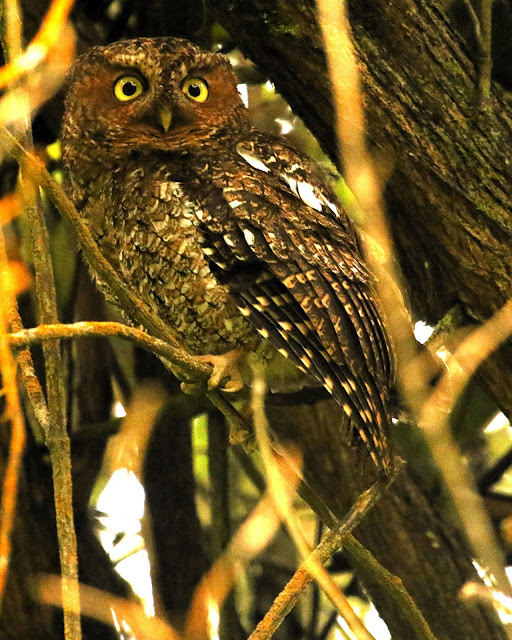And it's the owls that I'm focusing on here. There's a particular thrill that comes from finding an owl. Maybe it's the chance to get a glimpse of a creature from the mysterious night-time world. (I'm a moth recorder, so this could be personal bias.) Or perhaps it's the forward-facing eyes into which we can read very human expressions. Owls have traditionally been considered to be intelligent: Athena, the Greek god of wisdom, was often portrayed with a small owl - probably the Little Owl which bears the scientific name Athene noctua. In practice, I doubt whether they are cleverer than any other raptor.
Either way, owls are very much sought after by birders and we were no exception. Our guide, Pat O'Donnell (website here) wanted to show us as many as he could. Spotlighting had already brought us a Black-and-White Owl in the rainforest at Pocosol, a Pacific Screech-Owl outside the northern town of Los Chiles and a Central American Pygmy-Owl in the Sarapiqui area, while a Ferruginous Pygmy-Owl put in a daylight appearance in the lowlands of the north Pacific coast. We even came across two Barn Owls: some lists class this as a separate species (American or Western Barn Owl Tyto furcata) to the Eurasian Barn Owl, but the split is not recognised by the HBW/Birdlife Checklist.
But for me, the best owl encounter of the trip was with the magnificent Bare-shanked Screech Owl pictured at the start of this blog post. We saw it on the slopes of Volcan Irazu at around 2,900 metres (9,500 feet or so) altitude. The summit of the volcano, which remains active, is higher still - 3,432 metres (11,260 feet) to be exact - and we had already travelled up into the mist to peer at Timberline Wren and Volcano Junco through the gloom. We didn't get into the National Park though, as a gate and fence bars entry to all but pre-booked visitors, which seems unecessarily unfriendly; try doing that in the English Lake District! In any event, the gate was unstaffed and firmly closed at the early hour of our arrival.
Instead, we drove some distance down the road and walked a lower trail at Nochebuena, where for a small fee you can explore an area of farmland dotted with trees and small wooded areas. Pat had visited here before, and knew that a wooded gully at the edge of the farm was a possible place for the screech-owl. And it didn't take much calling before the bird flew in, first to a thicket in front of us, giving intermittent glimpses, and then right over our heads and into a tree where it sat glaring out of the gloom with fixed intensity.
%2025.10.24.JPG) |
| Bare-shanked Screech Owl - near Irazu, Costa Rica |
Bare-shanked is one of the larger screech-owls, and its range only extends across Costa Rica, Panama and a small slice of NW Colombia. Found at higher levels (above 900m or 3,000 feet as far as the timberline), it favours woodland edge habitats rather than continuous closed forest. Its prey is a variety of small mammals and large insects. Identification was not difficult: Bare-shanked is the only Costa Rican screech-owl found in forests this high up the volcano, although in other parts of its range it can overlap with Pacific Screech-owl. In such areas, Bare-shanked can be distinguished by its rufous-brown facial disc (not light brown), and the absence of a black facial border (which is found in Pacific Screech-owl). To my eyes, Bare-shanked Screech-owl also has a more severe expression, but maybe I am excessively anthropomorphising!
Unfortunately, our trail walk at Nochebuena was cut short by a downpour of biblical proportions, one of the few times on the trip when the weather significantly impacted our birdwatching experience. When doing the planning I had been apprehensive about visiting Costa Rica in October, as this is still strictly part of the rainy season. Maybe we were lucky, but we seemed to dodge many of the worst showers, with the benefit that most of the places that we visited were largely (or entirely) devoid of other visitors. Anyway, on this particular morning the rain looked to be well set in, so we cut our losses and dived into a nearby restaurant (the Sueños del Irazú) for a highly acceptable late breakast, before making out way down the volcano and on to Alajuela. The owl encounter had made my day!


No comments:
Post a Comment